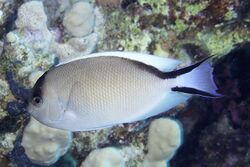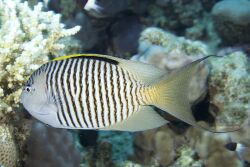Biology:Genicanthus caudovittatus
| Genicanthus caudovittatus | |
|---|---|

| |
| Female specimen | |
| Scientific classification | |
| Domain: | Eukaryota |
| Kingdom: | Animalia |
| Phylum: | Chordata |
| Class: | Actinopterygii |
| Order: | Perciformes |
| Family: | Pomacanthidae |
| Genus: | Genicanthus |
| Species: | G. caudovittatus
|
| Binomial name | |
| Genicanthus caudovittatus (Günther, 1860)
| |
| Synonyms[2] | |
| |
Genicanthus caudovittatus, the zebra angelfish, swallowtail angelfish, and lyretail angelfish, is a species of marine ray-finned fish, a marine angelfish belonging to the family Pomacanthidae.[3] It is found in the Indian Ocean.
Description
Genicanthus caudovittatus shows sexual dichromatism, the males and females have differing colouration. The males are whitish-blue marked with vertical dark brown barring and a black band running along the middle of the dorsal fin base. The females are pale pinkish grey with a black band over the eye and a black band on the upper and lower margins of the caudal fin. Both sexes have a markedly forked caudal fin.[4] The dorsal fin contains 15 spines and 15–17 soft rays while the anal fin has 3 spines and 17–19 soft rays. This species attains a maximum total length of 20 centimetres (7.9 in).[2]
Distribution
Genicanthus caudovittatus is distributed in western Indian Ocean where it occurs along the eastern coast of Africa from the Red Sea in the north to KwaZulu-Natal in South Africa, east to Madagascar, Maldives, Mauritius, and Réunion. It has also been recorded from Weh Island off northwestern Sumatra.[1]
Habitat and biology
Genicanthus caudovittatus is found at depths between 15 and 70 metres (49 and 230 ft).[1] In the Red Sea it can be found in shallower water than in the Andaman Sea.[2] It can be found on steep outer reef slopes where it lives in small groups made up of a male and a few females. It feeds on plankton.[1] Juveniles live at greater depth than the adults.[5]
Systematics
Genicanthus caudovittatus was first formally described in 1860 as Holocanthus caudovittatus by the German-born British ichthyologist and herpetologist Albert Günther (1830–1914) with the type locality given as Mauritius.[6] The specific name is a compound of caudus meaning “tail” and vittatus meaning “banded”, referring to the black markings on the tail.[7]
Utilisation
Genicanthus caudovittatus occasionally appears in the aquarium trade.[1]
References
- ↑ 1.0 1.1 1.2 1.3 1.4 Pyle, R.; Myers, R.F.; Craig, M.T. (2010). "Genicanthus caudovittatus". IUCN Red List of Threatened Species 2010: e.T165845A6147130. doi:10.2305/IUCN.UK.2010-4.RLTS.T165845A6147130.en. https://www.iucnredlist.org/species/165845/6147130. Retrieved 20 November 2021.
- ↑ 2.0 2.1 2.2 Froese, Rainer and Pauly, Daniel, eds. (2019). "Genicanthus caudovittatus" in FishBase. December 2019 version.
- ↑ "WoRMS - World Register of Marine Species - Genicanthus caudovittatus (Günther, 1860)". http://www.marinespecies.org/aphia.php?p=taxdetails&id=211794.
- ↑ "Genicanthus caudovittatus". Saltcorner!. Bob Goemans. 2012. http://www.saltcorner.com/AquariumLibrary/browsespecies.php?CritterID=84&filter=0. Retrieved 14 February 2021.
- ↑ Eran Brokovich; Shai Enbinder; Salit Kark; Nadav Shashar (2012). "A deep nursery for juveniles of the zebra angelfish Genicanthus caudovittatus". Environmental Biology of Fishes 80 (1): 1-6. doi:10.1007/s10641-006-9160-y.
- ↑ Eschmeyer, William N.; Fricke, Ron; van der Laan, Richard, eds. "Species in the genus Genicanthus". California Academy of Sciences. http://researcharchive.calacademy.org/research/ichthyology/catalog/fishcatget.asp?tbl=species&genus=Genicanthus.
- ↑ "Order ACANTHURIFORMES (part 1): Families LOBOTIDAE, POMACANTHIDAE, DREPANEIDAE and CHAETODONTIDAE". The ETYFish Project Fish Name Etymology Database. Christopher Scharpf and Kenneth J. Lazara. 21 July 2020. http://www.etyfish.org/acanthuriformes1/. Retrieved 14 February 2021.
External links
- Photos of Genicanthus caudovittatus on Sealife Collection
Wikidata ☰ Q2226061 entry
 |



